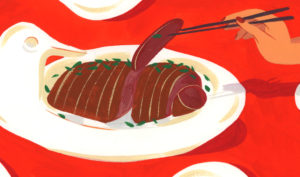Gazing down at the paper plate, I take a few moments to contemplate the meal in front of me. Is that a piece of wheat gluten masquerading as fried chicken, I wonder, poking at it with a chopstick? A speckled roll of yuba resembling steak? A ball of bean curd made bouncy like cuttlefish? Each year brings new discoveries, as I try to identify the animal of inspiration for each plant-based protein nugget doled out by nuns at the cafeteria. It’s sort of like trying to guess the fruit in a bag of Tropical Starburst.
I am at the Chuang Yen Monastery in New York’s Hudson Valley. Since my grandfather’s ashes were placed in an urn on the mountainside here 10 years ago, my family and I have paid visits, often for Qing Ming, a Chinese holiday of ancestral worship. The vegetarian meal served in the dining hall is a highlight—but if you’ve ever gone to any restaurant with the word “Buddha” in its name, then you’ve had this food, too: mock duck, mock char siu, mock chicken, and mock fish dishes galore. Elaborately prepared wheat gluten (sometimes called seitan), tofu, and other plant-based proteins are the building blocks for an inexhaustible variety of satisfying nonmeats that have been honed at Buddhist monasteries for centuries. The iterations never cease to delight me. Perhaps it’s because of my annual monastery visits that I’ve embraced them so richly. But I wonder, do other omnivores feel this way, too?
By Cathy Erway
